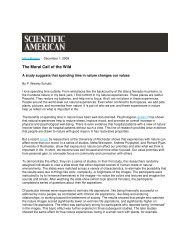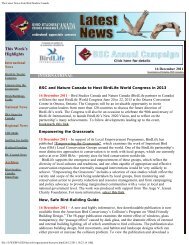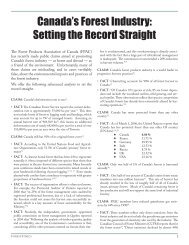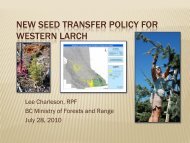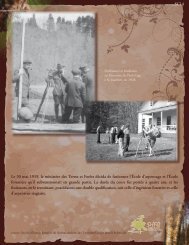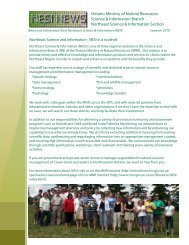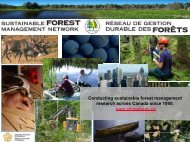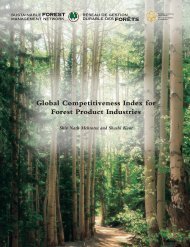a unique perspective a vision for canada's forests - Canadian ...
a unique perspective a vision for canada's forests - Canadian ...
a unique perspective a vision for canada's forests - Canadian ...
- No tags were found...
You also want an ePaper? Increase the reach of your titles
YUMPU automatically turns print PDFs into web optimized ePapers that Google loves.
the prairies. Currently less than half of the area harvested across Canada receivesassisted regeneration. A clear plan of action is urgently needed, particularly in easternCanada, to ensure <strong>for</strong>ests that require assisted regeneration receive the requiredtreatments.The low level of assisted regeneration may be less of a concern if comprehensivestrategies <strong>for</strong> natural regeneration are being implemented. Comprehensive strategiesrequire at a minimum the retention of sufficient parent trees capable of producing seed onthe harvested sites, good in<strong>for</strong>mation on seed crops and the exact timing of sitepreparation and vegetation control.We highly recommend the development of sound plans <strong>for</strong> areas where naturalregeneration is required, and the development of a national seed crop <strong>for</strong>ecastingsystem to assist in the timing of site preparation and tending operations.Table 1. Percent of harvest area treated and receiving assisted regeneration inCanada (excluding the Territories)JurisdictionPercent of Harvest Area Treatedby Year (treated area = planted,seeded and tended)Percent of Harvest Area Plantedand Seeded by Year1982-831 2005-062 1982-831 2005-062British Columbia 67 101 51 76Alberta 67 137 63 75Saskatchewan 32 70 32 65Manitoba 11 69 11 62Ontario 55 96 30 49Quebec 20 67 22 26New Brunswick 56 86 31 24Nova Scotia 29 76 12 26PEI 59 67 18 32Nfld&Lab 62 48 13 32Canada 46 87 31 461Weetman 19862Data source: National Forestry database <strong>for</strong> area harvested, planted,seeded and tendedForest Dependent CommunitiesAccording to the 2001 census over 300 communities across Canada rely upon <strong>for</strong>estry <strong>for</strong>50% or more of their economic activity. However, this definition is limited, as it tends tofocus primarily on communities dependent on the <strong>for</strong>est products industry. Forestdependent communities are even more numerous in Canada if one includes communitieswhere people’s well-being and sense of place depends on their surrounding <strong>for</strong>estenvironment. Support <strong>for</strong> <strong>for</strong>est initiatives are more likely to be supported if more<strong>Canadian</strong>s see a direct connection with the initiative and their understanding of <strong>for</strong>ests.- 90 -



